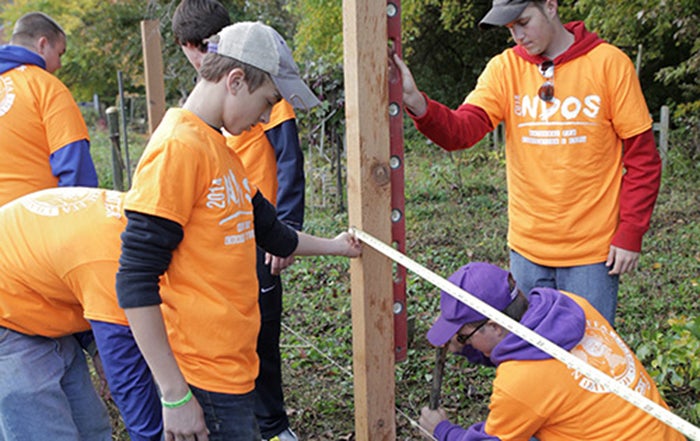Did you know it takes just one eye-opening experience to transform a student’s perception of agriculture and turn him or her into a lifelong advocate for the ag industry? Experiencing career and leadership development events, attending the National FFA Convention & Expo, completing an agriculture project and serving the community all give FFA members enhanced perspectives of agriculture that last long into the future. Read on for examples of how support for FFA is changing lives.
1. In 2019, donors gave more than $215,000 to help FFA provide 3,048 jackets through the Give the Gift of Blue program, which provides jackets to members who cannot afford them.
2. Donations of time add up to valuable contributions. In 2019, 66 FFA Alumni and Supporters chapters in 16 states reported donations of more than 44,210 hours of service to FFA chapters nationwide. Their time was equivalent to $1.12 million.
3. A recent gift of $1 million from Herman and Bobbie Wilson will enable the National Teacher Ambassadors for FFA program to have an even greater impact on agriculture teachers across the country. The gift will allow the program to exit the pilot phase and increase the number of teachers so every state and region are represented.
4. FFA chapters use Living to Serve Grants to meet needs close to home. Thanks to generous donors, chapters and states received $754,564 in Living to Serve Grants in 2018-19.
5. Lyle and Karma Orwig have included the National FFA Organization in their estate plans, with half their funds allocated to finance international travel for ag teachers. While he was a young Illinois FFA member, Lyle worked a summer job on a dairy farm in England. He hopes his endowment will allow ag teachers to experience agriculture in other countries and then encourage their students to think globally.
6. In its second year, the FFA Blue Room hosted 4,732 FFA members. Of all students surveyed, 98 percent said they learned how innovations in ag tech are solving some of the major problems facing our world, and 90 percent learned about a new career they hadn’t known was connected to agriculture. The FFA Blue Room was made possible by sponsors including AgriNovus Indiana and Microsoft.
7. The Washington Conference Endowment was established in 2019 to allow more students to experience the Washington Leadership Conference. The endowment was created by Rev. Dr. Cathi Braasch, and others can contribute to help secure the future of FFA.
8. The Roland-Story FFA Chapter in Iowa makes the most of National FFA Week each year by delivering homemade meals to senior citizens in need. The students not only grow produce in their chapter’s vegetable garden and distribute thousands of pounds of produce to local food pantries, but also make the meals using funds from their Living to Serve Grant from National FFA. Support from donors and sponsors for grants means young people can continue to do good in their communities and to learn hands-on skills to make the world a better place.
9. Former dairy farmers Eugene and Shawn Smith own two Culver’s restaurants in Idaho. They host an annual Agriculture Awareness Extravaganza for the community and donate 10 percent of that day’s revenue to their local FFA chapter. The Smiths also donate food and time to local FFA events and activities.
10. In 2020, more than $234,000 was raised with 1,440 donors contributing during Give FFA Day. The annual day of giving was celebrated this year on Feb. 25 with a 24-hour online pep rally for FFA. FFA.org/GiveFFADay.
You can learn more about the impact financial donations make for members at FFA.org. Just $65 registers one member for National FFA Convention & Expo; $80 provides an official FFA blue jacket to a member; $400 funds a Living to Serve Day of Service Mini-Grant; and $1,000 funds an SAE grant.












